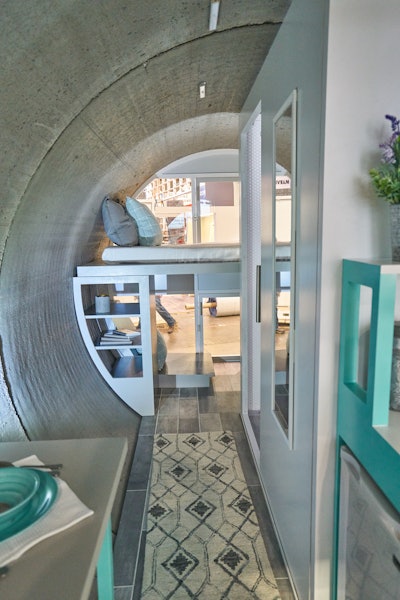
With the prevalence of homelessness and overpopulation across the country, Rinker Materials™ and the American Institute of Architecture Students (AIAS ) joined forces to make affordable, high-quality housing a reality through the vision of architectural student Sandra D. Guillen. A native of La Paz, Bolivia and the single mother of a 12-year-old son, Guillen tapped personal experiences to win the Rinker Materials/AIAS Pipe Dream tiny home design contest. Based on her design, the first tiny home built from concrete pipe in the U.S. was revealed at the International Builders’ Show (IBS) in Las Vegas on Feb. 19th.
Challenged to transform concrete pipe traditionally used for underground storm water management from Rinker Materials into a tiny home, Guillen bested other AIAS members by focusing on function and comfort. She also leaned on her dream of becoming an architect to reconstruct the 8-foot diameter, 16-foot long concrete pipe into a mobile, stackable, durable, sustainable and relatively inexpensive alternative to traditional housing. The next generation of tiny homes, concrete pipe is a real-world solution for homelessness and overpopulation as well as those displaced by natural disaster or simply unable to afford a home.
Who Needs a Home?
- 554,000 people are homeless on any given night (HUD)
- U.S. population growing 2 million a year or 240 people per hour (U.S. Census)
- Northern California wildfires displaced 50,000 (LA Times)
- Hurricane Florence forced 20,000 into shelters (N.C. Dept. of Public Health)
- Home values are 16% higher than in 2008 (Sharestates)
- Annual increase in earnings is 3% while annual home prices increase 5% (Reuters)
“As a child, my parents emphasized the importance of an education. In fact, my mother would playfully threaten to send me to live in a pipe under the bridge if I didn’t do well in school,” says Guillen. “While I understood her point, it was also a harsh reminder of the homeless problem around the world. When I heard about the Pipe Dream contest, I knew it was my opportunity to make a difference. Concrete pipe makes the perfect structure for a tiny home and hopefully my design will help many people live more comfortably. At the very least, this experience culminates my journey to earn a degree and sets a great example for my son.”
Extending the natural cool gray of the concrete pipe, Guillen integrated light blues and off whites into the home design. She chose these popular neutral colors to give the home a soft and welcome feel, while making the nearly 100 square-foot domicile seem much larger. The effect of enlarging the tiny home was also accomplished by incorporating tile surfaces, large French glass front doors and two retractable glass windows in the rear. A covered porch and large paver patio with grill significantly increase the living space outside of the tiny home as well. To streamline the process, Rinker Materials turned to fellow QUIKRETE® companies, Custom® Building Products and Keystone Hardscapes®, for the tile and paver installation, respectively.
Pipe Dream Home Highlights
- 48 sq. ft. of 6” x 24” plank tile floor in kitchen, bathroom and covered porch
- 50 sq. ft. of glass wall tile in kitchen
- 12” radiant electric cook top kitchen
- 15” x 15” x 6”drop sink in kitchen
- 100 sq. ft. white hex tile in bathroom
- Sink positive space-saving sink in bathroom
- Collapsible bed, couch and workstation in bedroom/office
- Paver planter for sustainable gardening
The wooden-frame, four-section modular tiny home design – kitchen, a bathroom, living area and combination bedroom/office – can be assembled in a Rinker Materials concrete pipe in less than a day (excluding electricity and plumbing). The 30 ton fire-resistant concrete pipe can be easily transported on a flatbed truck and simply requires eight commercial-grade rubber wheel chocks to stabilize the tiny home. While amenities will dictate the final cost of a tiny home built from concrete pipe, the prototype revealed at IBS was about $35,000. The core cost for the concrete pipe is about $14,000, so the overall tiny home could be more or less expensive depending on how it’s customized.
“Exploring our concrete pipe as a tool to fight homelessness and overpopulation alongside the AIAS has already proven to be a viable prospect,” says Tom Hartley, Vice President of Sales & Marketing for Rinker Materials. “Sandra’s unique perspective resulted in a smart, repeatable design that could truly make tiny concrete pipe homes accessible to anyone. Combine that with our national distribution and there isn’t a community we couldn’t potentially help. Ultimately, our long-term goal is partnering with HUD, FEMA and similar organizations to make tiny concrete pipe homes a reality for those in need.”
“We are incredibly proud of Sandra---and all of our members who contributed to this competition---for their bold and innovative spirit,” says Charlie Klecha, Interim Executive Director of the AIAS. “This competition and our partnership with Rinker Materials are valuable indicators of the kind of forward-looking and actionable progress that can be achieved when we open our minds to the voices of a new generation, and collaborate with them as equal partners in the crafting of more equitable and resilient built environment for all.”
For more details on the Pipe Dream project including photos and videos highlighting Guillen’s story, design concepts, construction and the future of tiny homes made of Rinker Materials concrete pipe, visit www.RinkerPipeDream.com.


















